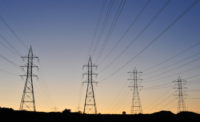The men and women’s basketball programs at the University of Connecticut (“UConn”) are widely recognized as two of the most outstanding in the nation. The men’s basketball team won the NCAA tournament in 1999, 2004, 2011, and 2014. The women’s team has won the National Championship a record 11 times, making it the most successful women’s basketball team in the country. Most recently, the UConn women’s basketball team completed an unprecedented 111 victories in a row.
But not only are the UConn Huskies leaders in athletics, they are also leaders in energy and water efficiency, both in the NCAA and in the facilities on their campus.
The UConn main campus in Storrs, CT is home to 30,000 students, faculty, and staff. Over 10.2 million sq ft of facilities are heated, cooled, and powered by a modern district energy plant and utility distribution system. The university is responsible for the operation and maintenance of all utilities, including power, water, and sewer.
Steam is generated at 125 pounds per square inch in the central utility plant by a variety of boilers. Five of the steam boilers are high-pressure industrial water tube boilers installed between 1963 and 1998. They primarily burn natural gas or ultra-low sulfur diesel fuel oil when gas is not available because of pipeline delivery curtailments. These five boilers were the primary source of heat for the campus until a new 30,000-sq-ft combined heat and power (CHP) plant was constructed beside them.
In 2006, through an $81 million design-build contract, the university constructed a 25-megawatt (MW) cogeneration plant. Though it is called the “cogen plant,” the facilities operate as a trigeneration plant and can simultaneously produce heat and power for the campus as well as chilled water from the single natural gas energy input.
At the heart of the system are three, 7.5-MW combustion turbine generators which generate 13.8 kilovolts (kV) of electrical power. The turbines are coupled to heat recovery steam generators (HRSGs) to convert waste heat and generate both 600-psig and 125-psig steam. The higher-pressure steam can be first directed to a 4.6 MW backpressure steam turbine drive generator to create electrical power before entering the 125-psig header. The lower-pressure steam can be directed to steam turbine driven chillers to generate chilled water. Each HRSG can generate 25,000 pounds per hour of steam in the heat recovery mode alone, and one can produce up to 70,000 PPH of steam when using auxiliary duct firing with natural gas. The HRSGs and the five conventional boilers have a total generating capacity of 530,000 PPH. The cogeneration system was originally expected to save over $180 million in operating costs over its expected life. The expected savings are now twice that after capitalizing on changing energy markets and more favorable refinancing.
The central chilled water system offers energy flexibility in many ways. Three different chiller technologies are employed to optimize energy usage and reduce operating costs. Eight chillers are located in the central chilled water plant and represent an installed capacity of 12,400 tons. Two of the chillers are conventional electric motor driven type, and two are gas engine driven and were installed prior to the arrival of the cogeneration plant. They represent a physical hedge against electrical price spikes during peak demand periods.
Four of the chillers are steam turbine driven and utilize 125-psig steam from the cogeneration system to maximize the overall efficiency of the plant. The most recent steam-driven chiller (“CH-8”) was commissioned in 2016. The new machine utilizes 20,137 PPH of steam to produce 2,100 tons of chilled water. In the summer season the steam turbine driven chillers are utilized most frequently and are the first machines to be energized. The gas engine and electric-motor-driven units are next, and they are used to meet cooling demands and balance the overall electrical peak.
In the trigeneration mode (combined heating, power, and cooling) the efficiency of the plant can exceed 80%. In the winter, steam is primarily used for campus heating, and the steam chillers are routinely secured for seasonal layup and planned maintenance while the gas and electric machines are used to meet normal cooling requirements. The opportunity to employ free cooling is also captured through the use of a plate-and-frame heat exchanger that takes condenser water on one circuit and cools the chilled water circuit whenever the outdoor air temperature is at 40°F or below. The free cooling system generates up to 900 tons of chilled water and is exercised frequently to defer the requirement to operate a compressor driven chiller, saving significantly on campus energy usage.
Self Sufficiency
One of the most important design parameters for a cogeneration or CHP system is correct sizing of the equipment. This will allow the system to maximize runtime and optimize cost-effectiveness through the operating year without relying on the external electric grid. UConn’s most valuable asset, however, may be its savvy operations staff who utilize their advanced operational control systems to oversee the development of the most efficient equipment. The UConn plant is permitted for 24.9 MW of electricity generation at 13,800 volts. Power is distributed from a campus-owned substation to each building, making it possible to reach as far toward the peak load of the campus of 26.5 MW as possible to allow for a high utilization factor year after year.
UConn’s utilities systems manager Tim Grady explains:
“The cogeneration system meets all campus power needs 100% of the time except during an annual outage of about 25 days. We hit our peak demand in August and use all of our plant assets to carry the load as much as possible. Ideally, we want the utility import meter to read ‘zero’ as much as possible. We may be importing 100 kW or exporting 100 kW, but it is close to even at all times. If we exceed our needs by 600 kW for more than 90 seconds, a circuit breaker opens because we are not allowed to export to the regional grid. Our efforts to match load have resulted in monthly utility company electric bills for the entire campus as low as $3,000.”
The Independent System Operator (ISO) is especially concerned about the summer weekday hours of 10 a.m. – 10 p.m. and winter weekday hours of 12 p.m. – 8 p.m. when the grid experiences the most activity. UConn typically operates all three combustion turbines on high demand days during the week. Typically, evening operations will include securing one of the three as the demand reduces. Weekend operations often require just two turbines to meet the campus’ electrical demand. The experienced staff balances the operations and maintenance costs ($/kWH) versus the revenue value when deciding which technologies to deploy. The cogeneration plant regularly produces well over 90% of the campus electrical requirements each year in producing 120 million kWH.
Resiliency
In the event of the unforeseen loss of utility power from the provider Eversource (New England’s largest energy provider), UConn’s system has full island mode capabilities allowing it to meet the majority of its electrical needs without the local utility. Two of the extended storm events in recent years disrupted community power delivery. UConn’s microgrid demonstrated its value when it was able to shift into island mode for approximately 10 days each time to provide stable power to the university while the utility grid was slowly being restored. The campus even served as a citizen safety center for neighboring communities during these utility grid outages.
The plant also benefits from being equipped with the features of an automated load shedding program that can curtail non-critical loads and keep most buildings fully functional during unusual events. The normal power delivery system has five circuits to the campus that each carries the load of approximately 20% of the buildings. An emergency power generator system supplements the cogeneration plant and includes three large diesel engine generators to produce 4 MW at 4,160 volts. These generators provide backup power to 25 buildings including the utility plant. The generators are used for “black start” operations, which allow the cogeneration plant to be restored without relying on the external transmission network in the event of a total blackout.
The cogeneration plant requires natural gas connection at 380-psig delivery pressure. A dedicated connection to the Algonquin transmission main (an underground high-pressure pipeline that serves New York, New Jersey, and the New England region) provides a reliable source without the need for onsite compressors. Eliminating the need for compressors improves the plant’s operating efficiency and reduces its operating costs. Connecticut Natural Gas provides care and servicing of the pipeline. If the gas supply is interrupted, the operating staff can switch the combustion turbines and boilers to burn low-sulfur diesel fuel oil supplied from 300,000 gallons of underground storage. Cold weather pipeline curtailments do occur. For example, in the winter of 2015, UConn had to rely exclusively on fuel oil for 30 days.
The utility plant became known as “Husky Power” and has demonstrated the ability to maintain a consistent level of 99.99% reliability.
Emissions
The cogeneration plant is an important component of the university’s climate action plan. UConn’s initial step — reducing baseline carbon emissions by 20% by 2020 — is on target.
Each combustion turbine is equipped with strict emissions controls for nitrogen oxides (NOx), which are most effective when the machines are operating at or above 50% of their rated power output. When campus loads are such that the 50% mark is not achievable, one machine will be secured and the other will ramp up to match the demand so that the NOx controls can be optimized and minimized.
The cogeneration plant is recognized as a generator of Class III Renewable Portfolio Standard credits. Approximately 25% of the RECS are returned to the Connecticut Clean Energy Fund for other statewide energy conservation initiatives. UConn has a healthy relationship with the State Department of Energy and Environmental Protection (DEEP), and DEEP has assisted with identifying projects that return cost effective savings.
Stan Nolan, director of utilities operations and energy management at UConn, explains:
“We are constantly communicating with our peers and agencies such as DEEP to ask, ‘What can we be doing within our own microgrid to lower energy demand?’ We look at all aspects of energy production and consumption. We strive for all new buildings to be LEED Gold. We have retrocommissioned 36 of the most energy intensive buildings on our campus and are about to retrocommission seven more. When we build a new building, we’ll retrocommission three or four of our existing stock to offset the increase in demand.”
In doing so, UConn partners with its utility companies to maximize the incentives and rebates that are available for energy efficiency measures like lighting and occupancy controls. The university has also refined its methods of purchasing fuel.
“We seek to have budget stability in the commodities we buy, so we hedge 85% of the natural gas purchase for a year and float the remaining 15%. We’ve learned to use reverse auction procurement methods for our electricity purchases to supplement the cogeneration, and it’s allowed us to lock in rates for the next four years. In the reverse auction all purchased power is 100% CT Class 1 (green) renewable electricity,” said Nolan.
Innovations
In 2013, the university began the operation of an onsite reclaimed water facility to provide tertiary treatment of wastewater to reuse in the central plant. A 3 million gallon/day water pollution control facility first treats the campus sewage. The new reclaim facility uses microfiltration and ultraviolet light disinfection to treat up to one million gallons per day of that effluent and create non-potable but high-quality water. This water can be used directly for cooling tower make-up, which consumes between 250,000 and 450,000 gallons of water each day through evaporation and blowdown. Boiler feed water also uses the reclaim stream as its primary make-up source and uses reverse osmosis filtration for finer treatment.
Historically, all of this “make-up” water originated from UConn’s two major water supply fields. The pumping of the water supply wells in drought periods were known to exacerbate low flow conditions in two nearby rivers. UConn’s $30 million investment into the reclaimed water facility relieved the strain on the well fields and provided an abundant source of cooling and boiler water. Reclaimed water has also been piped to several campus buildings with the goal of utilizing it for toilet flushing and cooling towers. UConn’s Office of Environmental Policy is now seeking permits through DEEP to utilize reclaimed water for irrigating certain athletic fields.
Renewal
With 43,000 ft of active steam and condensate piping dating back to the 1930s, maintenance requires constant attention. Most recently, the university became the first institution in the state to utilize an energy savings performance contract to repair and rehabilitate its underground infrastructure and existing buildings. The first phase of work is a $28 million effort to replace aged steam and condensate lines in its Hillside Road area.
Over 2,650 trench ft are being replaced along with eight valve vaults, all while the existing system remains active. Over one million sq ft of high-energy-use science buildings are being retrocommissioned to improve energy efficiency. These efforts are expected to save $1.5 million annually. The chilled water plant is undergoing further improvements. The older gas engine chillers that utilize R-22 refrigerant are being replaced by more reliable and environmentally-friendly R-134A machines. Currently, half of the chilled water system operates with a variable-primary pumping scheme, and the other half utilizes a primary-secondary configuration. To improve operational efficiency, the entire plant is now being converted to an all variable-primary pumping scheme.
Looking Ahead
The university has embarked on a Strategic Energy Management Plan that will improve the overall reliability and efficiency of its energy network. In addition to the steam distribution piping replacement work, all new, renovated, and existing buildings will be equipped with steam meters for granular energy monitoring. Piping loops and bridges will be constructed to provide interconnection capability for operational flexibility. The electrical substation will be upgraded to be a fully redundant N+1 system. The chilled water plant piping network will be expanded for redundancy of chilled water supply to buildings and chilled water energy meters will be installed at every building to monitor real-time use and inform the energy management system with much-needed competitive data.
The Next Generation Connecticut Initiative (“NextGen”) program represents $1.5 billion of new campus facilities to promote STEM (Science, Technology, Engineering and Math) programs. UConn’s investments in STEM education are expected to create economic growth in STEM and non-STEM related fields throughout Connecticut. To promote STEM education, new buildings are being constructed and dedicated to engineering, science, genomic studies, 3-D manufacturing, and other emerging fields. UConn will also see increased student enrollment as a result of the NextGen program. Higher rates of enrollment at UConn will increase demand for residential facilities.
The expansion of UConn’s STEM programs, campus facilities, and increased enrollment will create greater need for infrastructure improvement and higher demand for energy. The utility forecasting suggests that UConn may need another 10 MW of cogeneration and 6,000 tons of cooling to support this high-tech growth.
To manage growing demands for energy, UConn has partnered with Eversource to determine opportunities for energy-saving upgrades on campus facilities. The Harry A. Gampel Pavilion was identified as a location for upgrades. Several upgrades have been made to the pavilion, including the installation of VFDs to regulate air handlers. The lighting of the Gampel Pavilion has been upgraded to feature a new LED system which is 75% more efficient than the original system, will reduce operations costs by 80% , and will last for 10 years. In the future, the academic building, residential halls, and greenhouses are expected to undergo similarly cost-effective renovations.
Through this partnership, UConn will complete nearly 80 energy efficiency projects by the end of October 2017. Eversource estimates that these projects will save the university $1.5 million in energy costs, 9.5 million kWH, and result in CO2 reductions of more than 4,400 tons. Efforts to balance cost-efficiency and higher demands for utilities have earned the university recognition as one of the Sierra Club’s Top 10 Greenest Universities for five consecutive years. The continuation of these efforts will aid UConn in reaching its goal of becoming carbon neutral by 2050.
THE UNIVERSITY OF CONNECTICUT DISTRICT ENERGY SYSTEM AT A GLANCE
Electrical Generation
-
Three 7.5MW gas turbine driven generators
-
One 4.6MW steam turbine driven generator
-
Three emergency diesel generators with a total capacity of 4MW
-
13.8KV distribution & 4160V emergency distribution
-
105 automatic transfer switches
-
Own substation & relay system
Steam Production
-
Five stationary boilers (1963-1998)
-
Three heat recovery steam generators (2006)
-
Capacity: 530,000 pounds per hour
-
Pressure: Inside central utility plant – 600/125 psig, campus distribution – 65 psig
-
Six 50,000 gallon oil tanks
-
Fuel – Natural gas and no. 2 oil (ultra low sulfur diesel)
Chilled Water Production
North Plant
-
Capacity of 12,400 tons
-
Four steam driven chillers (2,100 tons each)
-
Two electric driven chillers (1,100 tons each)
-
Two gas driven chillers (900 tons each)
-
Free cooling heat exchanger (900 tons each)
South Plant
-
Capacity of 1,000 tons, 500 ton electric driven, and 500 ton gas driven.











